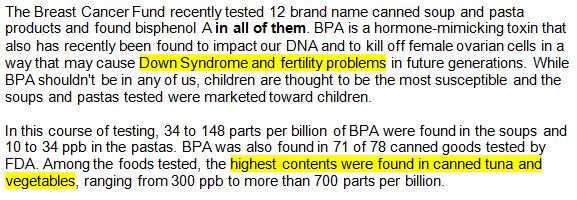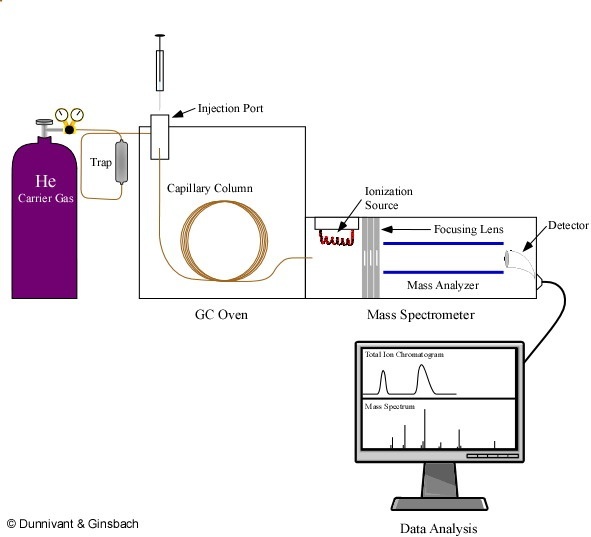|
Hello, we just thought you deserve to know Saturday, 5 January 2013
___________________________________________________________________
Are you safe? Will you turn infertile? Should you throw all your canned food away and tell your parents you'll live on plain rice for the rest of your life?
We assure you this is not a scam to get you to eat organic food or buy our super-XXX fertility pills.
And no, we don't sell those.
That aside, you have come to the right place, because this is where WE come in.
As you will read onwards, we have taken the courtesy to tell you all about this "feared" BPA, how it can harm you, why it is even used and how you can protect yourself (and your fertility).
__________________________________________________________________
References:Evans, K. (2011). How canned foods are poisoning us . Available: http://www.naturalnews.com/033818_canned_foods_BPA.html. Last accessed 17th January 2013. The chemical dangers of BPA [video] Friday, 4 January 2013 What BPA can do to your body Thursday, 3 January 2013 So... Is eating canned food really safe? Is it worth risking your life just for a quick meal? Well... Stay tuned to find out more ;) Yep, we're pretty sure Dr. Sokol thoroughly enjoyed this ^ In the above study, researchers compared sexual dysfunction between 230 males who worked at factories producing BPA and/or epoxy resins with 400 males from various industries who were not exposed to such levels of BPA Measurements were conducted using spot air and urine samples. It was discovered that the greater exposure one had to BPA, the more likely he experiences sexual dysfunction. This dysfunction was apparent even in workers who worked in a BPA factory for one year or less. ______________________________________________________________________________ There you have it, folks. But girls, don't be getting too happy yet: Yes, we even took the liberty to show screenshots because paraphrasing just doesn't get the full magnitude and authenticity across. Look at that bottle in your school bag now. Or those cans of food on your shelves. The use of BPA is frighteningly prevalent. What else are these industries hiding from us? Check out these articles to learn more about the effects of BPA: BPA causes changes in your brain, not just your body http://www.naturalnews.com/037241_BPA_nervous_system_plastics_chemical.html Childhood obesity linked to BPA in food packaging http://www.medicalnewstoday.com/articles/250454.php _____________________________________________________________________________ References: Rister, R. (2010). How Bisphenol A Products Affect Your Health. Available: http://www.steadyhealth.com/articles/How_Bisphenol_A_Products_Affect_Your_Health_a1275.html. Last accessed 5th January 2013. Hainer, R. (2009). Study links BPA in plastics to erectile dysfunction. Available: http://edition.cnn.com/2009/HEALTH/11/11/bpa.erectile.dysfunction/index.html. Last accessed 6th January 2013. Procedure & Analysis Wednesday, 2 January 2013 Method: Gas Chromatography coupled with a Mass Spectrometer (GC-MS) With GC-MS, we are able to determine the presence of a compound by using retention time and/or mass spectrum.
http://people.whitman.edu/~dunnivfm/C_MS_Ebook/CH2/Figures/Fig_2_5_GC-MS.jpg
BPA extraction: QuEChERS (Quick Easy Cheap Effective Rugged Safe.)
1. 10 grams of food samples were homogenized
for analysis by stainless steel blender together with 10ml of acetonitrile and spiked with BPA d16 as internal standard
2. In a plastic centrifuge tube, 10 g sample +
1.0 g NaCl + 4 g MgSO4 +10 ml acetonitrile were shaken for 2 minutes. (Phase-separation).
3. The mixture was centrifuged for 10 minutes
at 4000 RPM.
4. Take an aliquot of the upper organic phase
and subject it to dispersive Solid Phase Extratction clean-up by mixing it with MgSO4 and a
sorbent (e.g. Primary-Secondary Amines) to remove water and undesired
co-extractives.
http://www.biotage.com/graphics/9224.jpg
5. Sample was microfuged at 10,000 RPM and the supernatant is transferred into a GC vial.
2. Obtain the mass spectrum of the sample. 3. Compare with BPA mass spectrum from the library.
Quantitative (Internal Standard)
1.Prepare 5 known standards of BPA with different concentrations, using acetonitrile as a solvent and BPA d16 as the internal standard. 2.Use an auto sampler to inject 1 µL of each standard solution to see the detector response at each concentration level. 3.The normalised peak area is plotted against the concentration of the BPA standard to obtain the calibration graph. 4. Inject 1µL of the sample with contains BPA and introduce it into the GC-MS. 5. Calculate the concentration of BPA in the sample by using the calibration graph.
http://www.crawfordscientific.com/images/GC/agilent_DB5_HP5_HP5ms.jpg
References: Szyrwińska, K. et al. (2007) DERIVATIZATION AND GAS CHROMATOGRAPHY–LOW-RESOLUTION MASS SPECTROMETRY OF BISPHENOL A. [e-book] Poznań, Poland: p.54. Available through: Google http://www.us.edu.pl/uniwersytet/jednostki/wydzialy/chemia/acta/ac18/zrodla/05_AC18.pdf [Accessed: 21st January 2013]. JORDÁKOVÁ, I. et al. (2003) Determination of Bisphenol A, Bisphenol F, Bisphenol A Diglycidyl Ether and Bisphenol F Diglycidyl Ether Migrated from Food Cans using Gas Chromatography-Mass Spectrometry. [e-book] Prague, Czech Republic: p.86-87. Available through: Google http://www.agriculturejournals.cz/publicFiles/50833.pdf [Accessed: 21st January 2013]. Wang, X. et al. (2011) UCT Food Safety Application Modified QuEChERS Procedure for the Analysis of Bisphenol A in Canned Food Products. [e-book] Bristol, Pennsylvania: p.3. Available through: Google http://www.unitedchem.com/sitefiles/applications/The_Analysis_of_Bisphenol_A.pdf [Accessed: 22nd January 2013]. Quechers.cvua-stuttgart.de (2011) QuEChERS. [online] Available at: http://quechers.cvua-stuttgart.de/ [Accessed: 25 Jan 2013]. You must be thinking... So are you safe? Tuesday, 1 January 2013 The polycarbonate plastics and epoxy resins derived from BPA are lightweight and their usage is prevalent in many everyday objects .
Epoxy resins from BPA are used to form a protective coating in the inner
layer of metal can and bottle containers. These coatings help protect contents
from spoilage while extending their shelf life.
However, consumer products such as polycarbonate tableware, food storage containers, water bottles, and baby bottles are in danger of BPA leaching. The degree to which BPA leaches from polycarbonate bottles into liquid may depend more on the temperature of the liquid or bottle, than the age of the container. Protect yourself! You can tell if the plastic is made of BPA by looking for the No. 7 recycling symbol on the bottom:
http://cincovidas.com/wp-content/uploads/2012/04/7-Other.jpg
References: Unknown. (2009). BPA Used to Make Plastics and Coatings. Available: http://www.factsaboutbpa.org/how-is-bpa-used/bpa-uses. Last accessed 13th January 2013.
_______________________________________________________________
Even our classmates are using BPA free bottles!
Deryck is very health conscious when it comes to bottles.
|
And the awesome Jaclyn Ng  Dedicated to Mr Liew Profile Two absolutely non-mugger students
MBIO 2F02 INAC Project Blog Tagboard stay away. nono don't post here.
Affiliates NONE. We work alone.
Archives None. Because duh.
»January 2013 Credits Just so we aren't prosecuted for stealing
Manipulation : Jac & Hongyi. | |







.jpg)






